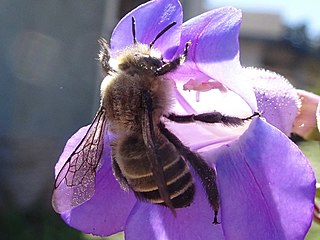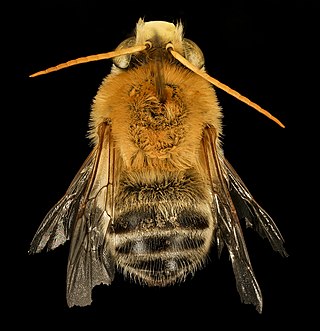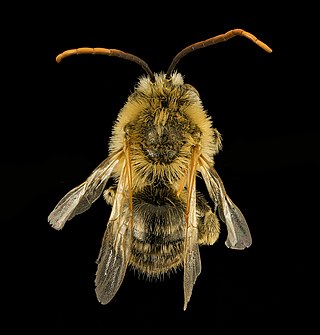
The Apinae are the subfamily that includes the majority of bees in the family Apidae. It includes the familiar "corbiculate" bees—bumblebees, honey bees, orchid bees, stingless bees, Africanized bees, and the extinct genus Euglossopteryx. It also includes all but two of the groups that were previously classified in the family Anthophoridae.

The Eucerini are the most diverse tribe in the family Apidae, with over 32 genera worldwide that were previously classified as members of the family Anthophoridae. All species are solitary, though many nest in large aggregations, and large "sleeping" aggregations of males are found occasionally. Most genera are distinctive in the unusually long male antennae from which the tribe derives its name. They are most diverse in the Western Hemisphere.

Liatris spicata, the dense blazing star or prairie feather, is a herbaceous perennial flowering plant in the family Asteraceae. It is native to eastern North America where it grows in moist prairies and sedge meadows.

Triepeolus is a genus of cuckoo bees in the family Apidae. There are at least 140 described species in Triepeolus. The majority of species whose life history is known are kleptoparasitic in the nests of bees in the tribe Eucerini, especially the genera Melissodes and Svastra.

Diadasia bituberculata is a species of chimney bee in the family Apidae. It is found in Central America and North America.

Melissodes bimaculatus, the two-spotted longhorn, is a species of long-horned bee in the family Apidae.

Melissodes is a genus of long-horned bees in the family Apidae. There are 129 described species in Melissodes.

Melissodes rivalis is a species of long-horned bee in the family Apidae. It is found in North America.

Melissodes agilis, the agile long-horned bee, is a species of long-horned bee in the family Apidae. It is found in Central America and North America.
Syntrichalonia is a genus of exquisite long-horned bees in the family Apidae. There are at least two described species in Syntrichalonia.

Martinapis luteicornis, the yellow-horned morning long-horned bee, is a species of long-horned bee in the family Apidae. It is found in Central America and North America.

Martinapis is a genus of long-horned bees in the family Apidae. There are at least three described species in Martinapis.

Melissodes communis, the common long-horned bee, is a species of long-horned bee in the family Apidae. It is found in Central America and North America.

Melissodes dentiventris is a species of long-horned bee in the family Apidae. It is found in North America.
Melissodes stearnsi is a species of long-horned bee in the family Apidae. It is found in North America.

Melissodes tepaneca, the tepanec long-horned bee, is a species of long-horned bee in the family Apidae. It is found in Central America and North America.
Melissodes paroselae, the parosela long-horned bee, is a species of long-horned bee in the family Apidae. It is found in Central America and North America.

Melissodes trinodis is a species of long-horned bee in the family Apidae. It is found in North America.

Symphyotrichum firmum, commonly known as shining aster, shiny-leaved aster, smooth swamp aster, and glossy-leaved aster, is a species of flowering plant in the daisy family Asteraceae native to Canada and the United States.














